
International Cricket Captain III
Written by: Rik
Date posted: May 8, 2020
- Genre: Sport
- Developed by: Childish Things
- Published by: Empire Interactive
- Year released: 2007
- Our score: 6
As a summary of just how cool a dude I was back in the late 90s, the revelation that much of my time in the first couple of terms at university was spent not only playing a computer game, but one based on cricket tactics and management, just about does the job. Sure, games were slowly becoming more widely acceptable, but not *that* widely acceptable. Championship Manager 3 might have been ok, but International Cricket Captain 2 was less so: one of my immediate neighbours, a pony-tailed archaeology student with an interest in live action role-play, once ventured that he considered it a little bit too nerdy.
Still, Anthony the LARP-ing archaeologist aside, I was surrounded by a reasonably forgiving bunch, including some with an interest in the sport, and it was a game that fitted in well with the student lifestyle of the time, lending itself to substantial periods of low-key time wasting, as colleagues found the prospect of seeing how my imaginary Yorkshire team were faring a more enticing one than going to the library or attempting to get on with some coursework. Unlike solo sessions of Championship Manager, in which the speed of play was liable to turn into a frenzied descent into madness, as the player became increasingly determined to turn around the declining fortunes of their faltering side, games of ICC 2 could progress at a more relaxed pace, with lazy afternoons spent half-watching 2D highlights of an inconsequential County Championship match accompanied by the dulcet tones of the in-game commentator, the BBC’s cricket correspondent, Jonathan Agnew.
In uncertain times, one pines for calm and comfort, and so under the current circumstances, I decided it was time to revisit the series again. Which brings us to International Cricket Captain III, which, due to the confusing naming practices of sports series, is not actually the immediate follow-up to the second game, but roughly half a dozen titles down the line. Presumably the use of a number rather than a year was to signpost a significant change, in this case a long overdue overhaul of the highlights engine, as opposed to a seasonal update, although it was the last game in the series to do so. So instead of the slightly generic and dated sprite-based highlights that featured in previous titles, we now have polygonal ones that look a little bit better.
Dealing with those first, the switch to 3D is overall fairly relatively successful, and although the technology is endearingly still several years behind 2007-era expectations, stuck at 800×600 with relatively basic player models appropriate for a game from 2001 or so, the animations are perfectly acceptable and produce largely believable and watchable cricket scenes. So watchable, in fact, that County Championship matches are witnessed by stadia packed full of spectators, rather than one man and his dog, as is the reality. But aside from the slightly eccentric hairstyles on display (60s Beatles ‘dos seeming to be particularly en vogue) and relentless advertising for Empire’s Taito Legends collections that were published around the same time, it sucks you in pretty successfully. (As does the advertising, as I did briefly consider buying a copy of Taito Legends). The fundamentals of a bowling action have been mucked up by games with higher profiles and larger budgets (I’m looking at you, EA Cricket) but they’re spot-on here.
In most other respects, though, it’s striking how little else has changed in the eight or so years since ICC 2 was released, and you’d be hard-pressed to identify significant differences between the two. For the game-buying public of the time, this may have been considered more of an outrage than for the ageing and complacent retro gamer picking up a copy for 50p in the local charity shop, but it’s still interesting to note, particularly if you compare progress with the ever-changing Football Manager series, for which skipping eight years’ worth of updates would likely have terminal consequences for your understanding and enjoyment. For me, it was therefore both a positive and a negative: although the limited ambition of this update was a surprise, it meant the game was easily accessible and provided swift access to revisiting those fond feelings from the past.
A brief recap on what International Cricket Captain generally involves: not only are you responsible the on-field captaincy of a cricket team, but also for the off-field management of the club as well. In other words, it’s a role that encompasses elements of a captaincy and a coaching role, which doesn’t really exist in real life, in order to provide a broadly equivalent experience to a typical football management game such as the aforementioned Championship/Football Manager. As with that series, and despite the presence of the word ‘International’ in the title, the fun here is with the domestic English county game, with international honours a later (and perhaps unwanted) distraction.
Financial management is again limited to the allocation of funds to training/coaching, physio sessions and the youth team in the first instance, and then wages, signings and contracts after your first season is completed (you’re stuck with your predecessor’s real-life choices for the initial 2007 season). Coaching decisions basically amount to allocating practice sessions to individual players, although this time there is a distinction between practice, supposed to help experienced players in the here and now, and technique, supposed to aid development of younger players. Another new feature, to me at least, is the ability to instruct the groundsman to prepare the pitch for home matches to suit the strength of your team.
Otherwise, though, the bulk of the activity is on the field, and much is familiar about the setup. You pick the team, take note of conditions at the toss, and find yourself either batting or bowling. Batting is fairly straightforward, and you simply set the aggression level of each batter depending on their ability, how settled they are at the crease (based on how long they’ve been in), the conditions, the match position and the bowling they’re facing. While bowling, meanwhile, you set the field, rotate your bowlers and set their instructions: what line and length to bowl, and how aggressive you’d like them to be (in ICC 2, there was no independent option regarding bowling length, and it was implied that low aggression meant a full length, and high aggression = bouncers). As before, the main in-game screen gives you access to relevant information about the match situation and other statistics, punctuated by highlights of the action such as wickets and boundaries (although you can adjust the frequency of these, from watching every ball to turning them off entirely).
So there’s not a lot to get your head around as a returner to the series, or – I’d argue – as a reasonably cricket-literate newcomer. By boiling the real-life game down to the relatively simple stuff most likely to be of interest (much as Championship Manager didn’t bother you with the economics of shirt sales or the pie shop) it’s pretty easy to get into and enjoy a few matches. Because you don’t expect to win trophies straight away, particularly without shaping the team in any way yourself, results also seem less important at first. Plus, as there are only a handful of trophies to win and with two divisions and no international competition, interim achievements are less easily defined, and so simply not getting thrashed all the time and being able to set moderate goals can be quite relaxing.
As time progresses, however, some of the game’s shortcomings become apparent and begin to irritate. As I mentioned in the previous review, the opportunities for clever captaincy in the field are rare: anyone with visions of analysing a player’s strengths and weaknesses to the extent that you might put a fielder in an unusual position and have the batsman hit a catch there will be disappointed. So generally it is a case of using the default field settings, regardless of how much they might not make much sense in reality: a short-leg fielder would be rarely used in a one-day game but is a position that features in most default field settings, and lots of catches are taken there. As a lazy and unimaginative captain, of the ‘two slips and the rest of you spread out’ variety, I wasn’t personally that bothered, but it does rather make you wonder what in fact you are doing apart from tinkering with a few settings. I suppose it could be said that when things go wrong for a captain in real life, it is likely very easy to feel out of control, and when on the receiving end of a pummeling from opposition batsmen, particularly in a four-day county match, the temptation is to mentally switch off and wait for it to be over.
As a general rule, proactive captaincy (mixing up the bowling, changing approach from over to around the wicket, and tinkering with the field) seems to be rewarded, but beyond that, there are lots of other things that don’t quite add up. In particular, pitch and overhead conditions don’t seem to affect play in quite the way you’d expect. A general trend of pitches getting easier to bat on the longer matches go on can be identified, which doesn’t make a lot of sense, particularly when you observe the various in-game indicators stating that the pitch has deteriorated and should be bad for batting as the opposition races towards an ambitious fourth-innings target. (Teams scoring 300 plus in the last innings should be relatively rare, but it happens a lot here, both for and against you).
As such, the importance of ground preparation, the toss, and team selection sort of goes out of the window as you pick your strongest overall side and hope for the best. It also makes you risk averse when it comes to forcing a win in the Championship: wins are needed for big points, but you end up taking a draw rather than risk a defeat by seeing the other team knock off the runs. The logic of some of the settings can also be questioned: for example, bowling at leg stump is not really advisable as a strategy in any form of cricket. The manual advises that this is the most aggressive line of attack, but if that is the case, then what purpose does the aggression rating serve? And bowling short for spin or medium pace bowlers is never a good idea, regardless of the preferences of the batsman. Also, you may specify to your bowlers that they should bowl short or full but then the highlights show them doing the opposite of what they have been told. Obviously, it could be argued that they aren’t machines who just do what you tell them, but the same questions come up while batting: are your batsmen still playing to the situation themselves or mindlessly following your instructions? It’s hard to tell.
The lack of information about your players also continues to be a problem. You basically only have their playing record to go on, which some might say is more accurate than looking at a load of stats, but there’s no way to judge future potential or ability other than by performance in matches. On that note, I had a long-running battle to work out why my pace bowlers were performing so badly when many of them were international players. After my first season with Yorkshire (of course), I put the struggles of Darren Gough and Matthew Hoggard down to their age. Reasoning that they might both be past it, I brought in Stuart Broad and Graham Onions, who may not have completed their rise to full real-life prominence at the time of the game’s release, but still had some international pedigree, to no great effect. Tim Bresnan, another international bowler, was equally ineffective, and if it hadn’t been for the leg-spin of Adil Rashid, I would really have been in trouble.
You’d also say that fielding isn’t really addressed here in any way at all: players drop catches but there’s nothing you can do about it, because you don’t have any information on whether individuals are good fielders or not, and no way for them to work on it either. Wicket-keepers seem largely incompetent across all county sides, letting plenty of byes through per game, and I don’t know whether that’s a reflection of their unseen fielding abilities or just a glitch.
Such things, along with the limited scope for transforming a club quickly because of the way player contracting and transfers work in cricket, make ICC III’s long term appeal rather limited. There’s no way to react to injuries or the realisation that the squad isn’t good enough without first sticking out the rest of the season. In real life, the rules on overseas players in country cricket changed dramatically during the 00s, and 1999’s ICC 2 depicted a world of the single loyal player for the season, which was soon relaxed and led to a complex situation where multiple overseas pros signed for short-term spells around their other commitments. I can’t recall (or easily Google) the exact rules for 2007 but it looks like a maximum of two per team, with replacements, were permitted at the time. Here, though, there’s no possibility of easily seeing when your signings might be called away on international duty, and certainly no way to replace them mid-season. In my third year, frustrated with the lack of penetration from my pace bowlers, I elected to bring in ex-New Zealand captain and left-arm spinner, Daniel Vettori, to complement Rashid as part of a twin-spin attack, but he played one game and was then absent with NZ commitments which weren’t flagged previously. Rashid then got injured and so I was back to the same hopeless seamers.
Having said that, for all of its shortcomings, ICC III still provides some good low-key fun in the short term. The highlights are very watchable (backed up with solid voice work from Agnew) and, when the match situation demands it, you get quite into them, wondering whether the next short clip of action will be positive or negative. You never have the feeling that you’re watching the same clips over and over again and when one of your bowlers is on a roll you can really feel it. (As someone who feels that a left arm seamer getting an lbw with an inswinger is one of the most beautiful sights in cricket, I signed Australia’s Nathan Bracken: he was no [ICC2 cult hero] Paul Hutchinson, but he still had his moments in this regard). The only area where things don’t really ring true is in the one-day game where sixes are rare and achieved with rather eccentric shots, and totals seem relatively conservative. But this is perhaps as much to do with recent batting advances in the global limited-overs game rather than any significant shortcomings here.
Despite their rudimentary appearance, players do have personality (I particularly enjoyed Andy Caddick’s grey hair and the dreadful ponytail assigned to Jason Gillespie) and opponents who vex you for no good reason over a number of games do get under your skin: Steve Harmison’s brother Ben always seemed to score hundreds against me, despite a modest overall record. Plus of course you superimpose personalities onto your own team, as they do well – or not. (Although I’m sad to note that there are no longer pictures of each player, so you can’t find the files and vandalise them in MS Paint). You can always tell whether a sports game has the right ‘feel’: in the wrong hands (EA) a big budget can still deliver a game that feels amateurish. ICC is obviously a product of more modest means but still has that feeling of authenticity.
The series has continued (wisely dropping the ‘International’ from its title some time in the last decade) and also attracted an independent rival, in the form of Cricket Coach. However, much like the hardcore following who eschew Football Manager in favour of Championship Manager 01/02, I’m not sure exactly how much more complexity or development I’d actually like, in reality. (I would be quite a bad cricket captain: indeed, I *was* quite a bad one, going back to those same university days). ICC was never in the same league as CM, even when the latter was a much simpler game, and it’s not something that holds the attention after the first few seasons or so. But in terms of delivering an accessible return to the series for me, and a reasonably laid-back experience overall, ICC III certainly did the trick.

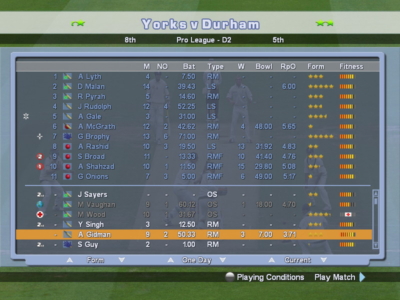
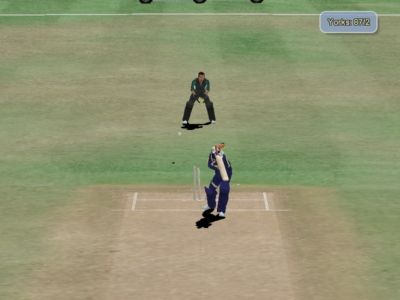
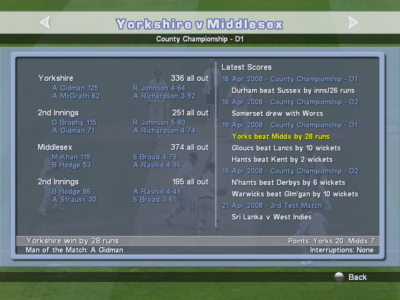
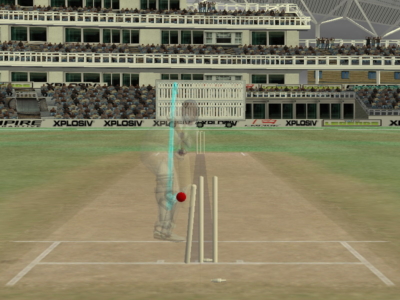
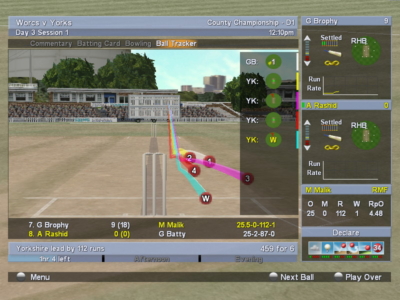
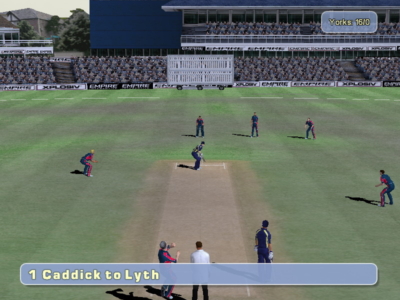

 Posts
Posts